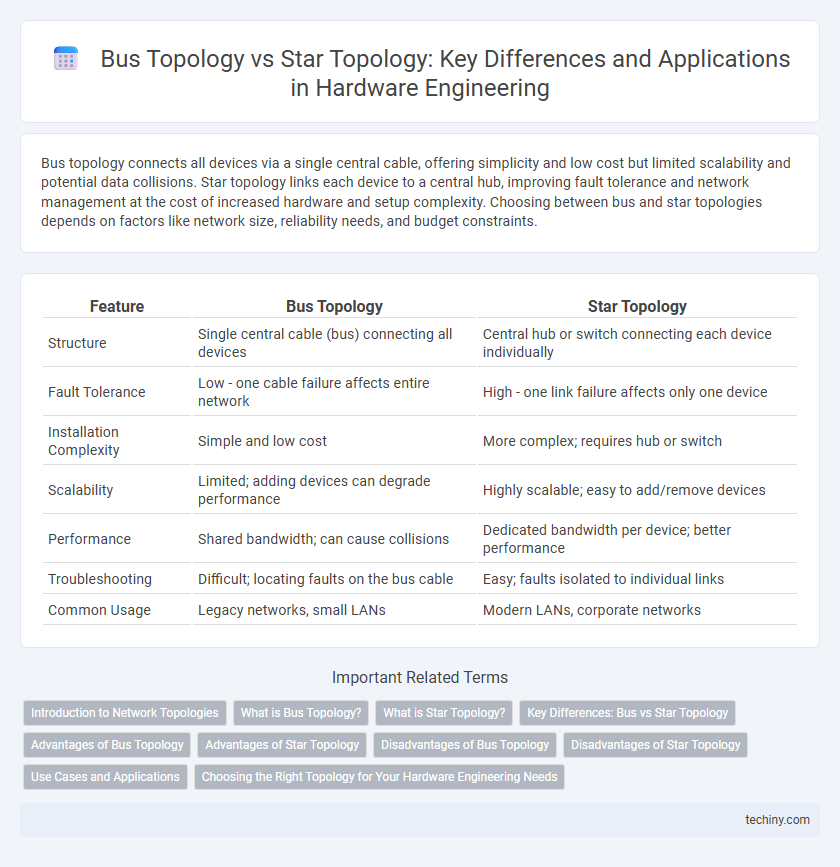Bus topology connects all devices via a single central cable, offering simplicity and low cost but limited scalability and potential data collisions. Star topology links each device to a central hub, improving fault tolerance and network management at the cost of increased hardware and setup complexity. Choosing between bus and star topologies depends on factors like network size, reliability needs, and budget constraints.
Table of Comparison
| Feature | Bus Topology | Star Topology |
|---|---|---|
| Structure | Single central cable (bus) connecting all devices | Central hub or switch connecting each device individually |
| Fault Tolerance | Low - one cable failure affects entire network | High - one link failure affects only one device |
| Installation Complexity | Simple and low cost | More complex; requires hub or switch |
| Scalability | Limited; adding devices can degrade performance | Highly scalable; easy to add/remove devices |
| Performance | Shared bandwidth; can cause collisions | Dedicated bandwidth per device; better performance |
| Troubleshooting | Difficult; locating faults on the bus cable | Easy; faults isolated to individual links |
| Common Usage | Legacy networks, small LANs | Modern LANs, corporate networks |
Introduction to Network Topologies
Bus topology connects all devices through a single central cable called the bus, allowing data to travel in both directions but creating potential bottlenecks and collision issues. Star topology features individual devices connected to a central hub or switch, improving fault tolerance and making network management easier by isolating failures to single nodes. Network performance, scalability, and maintenance requirements vary significantly between the two, influencing their suitability in different hardware engineering designs.
What is Bus Topology?
Bus topology is a network configuration where all devices are connected to a single central communication line called the bus. Data transmitted by any device travels along the bus and is received by all devices, but only the intended recipient processes it. This topology is cost-effective and simple to implement but can suffer from data collision and limited scalability.
What is Star Topology?
Star topology is a network configuration where each device connects individually to a central hub or switch, enabling efficient data management and minimizing collision domains. This setup simplifies fault isolation because a failure in one cable affects only the connected device without disrupting the entire network. Star topology offers enhanced scalability and performance compared to bus topology, which relies on a single communication line shared by all devices.
Key Differences: Bus vs Star Topology
Bus topology connects all devices along a single communication line, causing potential data collisions and limited scalability, while star topology links each device to a central hub, enhancing fault tolerance and ease of troubleshooting. Bus topology's simplicity and cost-effectiveness suit small networks, whereas star topology provides better performance and reliability at the expense of higher cabling requirements. The central hub in star topology acts as a critical point of failure unlike bus topology's distributed communication channel.
Advantages of Bus Topology
Bus topology offers a straightforward and cost-effective network layout by connecting all devices through a single communication line, minimizing cable usage compared to star topology. Its simplicity facilitates easy installation and expansion without requiring extensive hardware like switches or hubs. This topology also reduces the likelihood of network failure from a single device malfunction, as the main bus line carries all data traffic.
Advantages of Star Topology
Star topology offers superior fault isolation since each device connects independently to a central hub, preventing network-wide failures. It provides easier scalability and device management, allowing straightforward addition or removal of nodes without disrupting the entire system. Enhanced performance results from dedicated point-to-point connections, reducing data collisions and improving overall communication speed.
Disadvantages of Bus Topology
Bus topology suffers from significant drawbacks such as limited scalability and frequent data collisions due to a shared communication medium. Faults or breaks in the main cable can disrupt the entire network, leading to low reliability and difficult troubleshooting. These limitations make bus topology inefficient for large or complex hardware engineering networks compared to star topology's isolated device connections.
Disadvantages of Star Topology
Star topology in hardware engineering often faces disadvantages such as dependency on a central hub or switch, making the entire network vulnerable if this device fails. The increased cabling requirements lead to higher installation costs and complexity compared to bus topology. Troubleshooting can be more challenging due to potential points of failure concentrated at the central node.
Use Cases and Applications
Bus topology is ideal for small networks with limited devices, such as in early LAN setups or simple sensor networks, due to its cost-efficiency and ease of implementation. Star topology excels in environments requiring high reliability and scalability, commonly used in modern office networks and data centers where centralized management and fault isolation are critical. Both topologies support different use cases but star topology is preferred for critical applications requiring stable performance and easy troubleshooting.
Choosing the Right Topology for Your Hardware Engineering Needs
Bus topology offers a simple and cost-effective solution for small-scale hardware engineering projects, enabling easy integration of devices along a single communication line. Star topology provides enhanced fault tolerance and performance by connecting each device to a central hub, minimizing the impact of individual device failures. Selecting the right topology depends on factors like network size, scalability requirements, budget constraints, and the need for reliability in mission-critical hardware systems.
Bus topology vs Star topology Infographic

 techiny.com
techiny.com